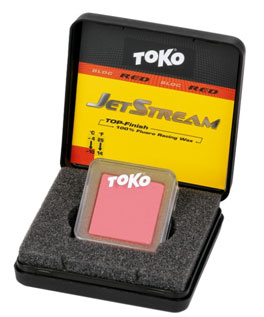
JetStream Application and Rotocorking Tips
Wed, Feb 2, 2011 - By Ian Harvey
 Applying JetStream
Applying JetStream
There are various ways to apply JetStream (or any other fluorocarbon). Sometimes the end result is the same and sometimes one method of application yields an advantage over another. Here are 3 main options and their merits:
- Rub on and rotocork. Overall, this is probably the most effective method of applying JetStream. It is certainly best in cold conditions (which we have a lot of in the US). It is also the most economical. Finish by brushing out with nylon polishing brush and polish with thermo pad. It is a good practice to do two applications. Rub, rotocork, then rub on over the top, rotocork, and then nylon polish and polish. This ensures a good application. Easy with the rotocork.
- Sprinkle powder (or rub), iron, and then rotocork. This is a very common method of application as well. It is good to use a hot iron (around 150C - see iron temperature recommendations on www.TokoUS.com info center page) and then to pass over the JetStream quickly (around 6 seconds tip to tail). If the ski is simply black behind the iron, the iron needed to move much quicker. The downside to moving the iron too slowly is that the finished product is slower, especially in fresh snow and cold snow. Again, rotocork conservatively. Best is to let the JetStream cool before rotocorking. This method is most advantageous in spring snow type conditions and is good all around. It is the most common application method on the Cross Country World Cup.
- Rub (or sprinkle), cork, and polish. This is a common practice on the Alpine circuit. The finish yielded is very fast. Durability is poor. Reapplication is quick and easy. After a run, brush the ski out (use nylon polishing unless it is dirty and then use copper) and reapply.
Rotocorking Tips
There seem to be two general schools of thought for rotocorking JetStream with both achieving good results.
The first and most common method is to use high rpms and barely touch the ski base with the cork. The waxer then goes back and forth over the ski with no pressure at all. This is pretty easy to do, although I think for many people it is more difficult to keep the rotocork flat.
The other is to keep the rpms extremely low and to use light to moderate pressure. One good pass from tip to tail is enough. With the low rpms and moderate pressure, it is easier to apply a clean finish with even pressure throughout the width of the ski.
In any case, do not rotocork for very long as it will be counterproductive. Of course the direction of the rotocork is such that it is trying to move the cork toward the waxer (not down the ski) assuming the rotocork is being pushed. Be conservative with the rotocork.
